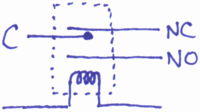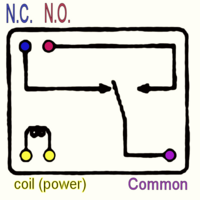Woozle's electronic learning kit No. 1 - parts and such
Jump to navigation
Jump to search
Electronics: Woozle's electronic learning kit No. 1: parts and such
Parts List
These are the Radio Shack part numbers; if I find alternate sources, I will list those too:
- 270-0391A "AA" Battery holder for 4 batteries (6 volts)
- 272-0802 assorted electrolytic capacitors (looks like about 18 of them; back of the pkg says 20)
- 272-1098 miniature 6v lamps (1 each: red, yellow, green)
- 275-0240 5VDC relay (ok up to 6.5 VDC according specs on back)
- 275-0702 auto flip-switch panel assembly
- 278-1156 pkg of 10 test/jumper leads with alligator clips (2 each: black, green, red, white, yellow)
Electrical Components
see Wikipedia (Electronic symbols) for more information
| The battery provides the power for everything else to happen. No circuit is going to do anything without a battery or other power source. The battery in this kit is actually 4 AA-size batteries in a holder. |
| The lights can be used either as illumination or as an indicator to show you that a circuit is active. There are 6 light bulbs in this kit, 2 of each color (red, green, and yellow). They are small lightbulbs and are mainly useful as indicators, although they look quite bright in a dark room. |
| The switches are used to turn circuits on and off. There are two of them in this kit, so you can control two different circuits. |
| A relay allows one circuit to control another. When the relay is turned on, it can turn something else on, or off, or both at the same time. There are two relays in this kit, so you can even use them to control each other. The wires connected to the coil control whether the relay is ON or OFF. When the relay is OFF, the wire labeled "C" connects to the wire labelled "NC" (Normally Closed -- in electric-speak, "closed" means "connected"); when the relay is ON, "C" connects to the wire labelled "NO" (Normally Open -- "open" means there is an open gap between two things, so they are not connected). |
| A capacitor can very quickly store a small amount of electricity, and then release it again. This is useful for slowing certain things down. For example, you can use it to make a small delay between the time when the power is switched off and when the relay clicks off. You can use that effect to do other interesting things. (Note: the capacitors in this kit are all electrolytic capacitors, which means that they work much better when the "plus" voltage comes in on the wire marked "+" instead of coming in on the other terminal.) |




